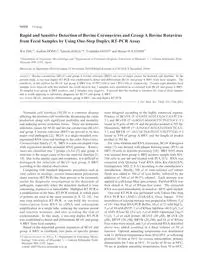
2011 Rapid and Sensitive Detection of Bovine Coronavirus and Group A Bovine Rotavirus from Fecal Samples by Using One-St PDF
Preview 2011 Rapid and Sensitive Detection of Bovine Coronavirus and Group A Bovine Rotavirus from Fecal Samples by Using One-St
NOTE Virology Rapid and Sensitive Detection of Bovine Coronavirus and Group A Bovine Rotavirus from Fecal Samples by Using One-Step Duplex RT-PCR Assay Wei ZHU1), Jianbao DONG1), Takeshi HAGA1)*, Yoshitaka GOTO1) and Masuo SUEYOSHI2) 1)Department of Veterinary Microbiology and 2)Department of Veterinary Hygiene, University of Miyazaki, 1–1 Gakuen Kibanadai Nishi, Miyazaki 889–2192, Japan (Received 14 September 2010/Accepted 22 November 2010/Published online in J-STAGE 6 December 2010) ABSTRACT. Bovine coronavirus (BCoV) and group A bovine rotavirus (BRV) are two of major causes for neonatal calf diarrhea. In the present study, a one-step duplex RT-PCR was established to detect and differentiate BCoV and group A BRV from fecal samples. The sensitivity of this method for BCoV and group A BRV was 10 PFU/100 μl and 1 PFU/100 μl, respectively. Twenty-eight diarrhea fecal samples were detected with this method, the result showed that 2 samples were identified as co-infected with BCoV and group A BRV, 26 samples were group A BRV positive, and 2 samples were negative. It proved that this method is sensitive for clinical fecal samples and is worth applying to laboratory diagnosis for BCoV and group A BRV. KEY WORDS: BCoV, detection, differentiation, group A BRV, one-step duplex RT-PCR. J. Vet. Med. Sci. 73(4): 531–534, 2011 Neonatal calf diarrhea (NCD) is a common disease affecting the newborn calf worldwide, threatening the cattle production along with significant morbidity and mortality and inducing severe economic losses. There are numerous infectious causes for NCD, and bovine coronavirus (BCoV) and group A bovine rotavirus (BRV) are proved to be two major viral pathogens [2]. BCoV is a single-stranded, non- segmented RNA virus and belongs to the order Nidovirales, Coronaviridae family [7, 9]. BRV is a non-enveloped virus with segmented double-stranded RNA genome. Rotavi- ruses are classified into 7 groups (A-G) [3] and group A rotavirus is the major cause of bovine rotaviral diarrhea [3, 14]. Due to the similar signs and symptoms, it is difficult to distinguish the infection of BCoV and group A BRV according to the clinical observation. Comparing with standard diagnostic procedures such as viral culture or serology, reverse transcription polymerase chain reaction (RT-PCR) has been proved to be extremely useful for diagnostic investigation in the detection of pathogens, especially when the detection method is time consuming, expensive or unavailable. Multiplex RT-PCR is a modification of the basic RT-PCR method, in which pairs of primers are used in the same reaction [4, 8, 12, 16]. For one-step multiplex RT-PCR, it can hold the reverse transcription from RNA to cDNA and subsequent amplification in a single tube, reducing the reaction period and reaction mixtures, and also avoiding the risk of contamination. In this study, a one-step duplex RT-PCR was established to detect and differentiate BCoV and group A BRV from fecal samples. Based on the deposited genome sequences of BCoV and group A BRV in GenBank, two pairs of specific primer were designed according to the highly conserved regions. Primers of BCoVF (5’-CGATCAGTCCGACCAATCTA- 3’) and BCoVR (5’-GAGGTAGGGGTTCTGTTGCC-3’) locate in N gene of BCoV and the predict product is 597 bp. Meanwhile, BRVF (5’-ATGGGTACGATGTGGCTCAA- 3’) and BRVR (5’-ACCGCTGGTGTCATGTTTGG-3’) locate in VP6 of group A BRV and the length of predict product is 383 bp. For virus titration and RNA extraction, BCoV Kakegawa strain [1] was titrated with plaque forming assay (PFA) on HRT-18 cells as describe previously [18]. BRV 6505 strain was isolated from group A BRV positive sample with MA- 104 cells in our lab and titrated with PFA [13]. RNA was extracted with QIAamp Viral RNA Mini Kit (QIAGEN, Germantown, MD, U.S.A.) according to the manufacture’s introduction. Briefly, 100 μl of virus-infected cell culture fluids was added to 560 μl of lysis buffer, followed by the addition of 560 μl of 99.5% ethanol. Each mixture was applied to a QIAamp Mini spin column. Purified RNA was then eluted in 50 μl of RNase-free water. The extracted RNA was used immediately or stored at –80C until needed. One-step RT-PCR was performed with Takara One Step RNA PCR Kit (AMV) (TAKARA, Otsu, Japan). Fifty microliters of reaction mixture was prepared as follows: 5 μl of 10× One Step RNA PCR Buffer, 10 μl of 25 mM MgCl2, 5 μl of 10 mM dNTP, 1 μl of RNase Inhibitor (40 U/μl), 1 μl of AMV RTase XL (5 U/μl), 1 μl of AMV-Optimized Taq (5 U/μl), 1 μl of each primer: BCoVF (20 μM), BCoVR (20 μM), BRVF (20 μM), BRVR (20 μM), and 18 μl of RNase Free water were mixed, and 5 μl of extracted RNA described above was added resulting in a final volume of 50 μl reaction. Optimal annealing temperature was determined with 11 different temperatures from 50 to 60C as following protocol: 30 min at 50C for reverse transcription; primary denaturation for 5 min at 94C; 35 cycles of 50 sec at 94C, 50 sec at gradient annealing temperatures from 50 to 60C, * CORRESPONDENCE TO: HAGA, T., Department of Veterinary Micro- biology, University of Miyazaki, 1–1 Gakuen Kibanadai Nishi, Miyazaki 889–2192, Japan. e-mail:
